
AjarnNorth
-
Posts
510 -
Joined
-
Last visited
Content Type
Profiles
Forums
Downloads
Posts posted by AjarnNorth
-
-
Thanks very much for that isanbirder.
Both new species for me.
Will look my dunno page and see what else is there.
Went out this morning and got a shot of a juvenile Bronze-winged Jacana.
Plenty of adults but this is the first juvenile for me.
When i lived on Huai Saneneg, a wetalands area in Surin, I had a lot of BW and PT Jacana. Most of the juv BW were in Jan and Feb, though i did have adults with chicks as early as October. I'm in Chonburi now and have not seen any Jacana as yet. Where are you, Robby?
-
Welcome, Robby!
The first one is a Shikra, but the second is an Asian Paradise Flycatcher, not a Monarch.
Agree on the Shikra, but the second one looks to me like a Grey-headed Canary Flycatcher.
Asian Paradise FC is a species I have been seeing pretty regularly as of late. Rufous upperparts and buffish breast and belly. Robby's bird has too much yellow to be APFC.
Will post some pics of each when i get home to my computer this evening.
-
Inornate would be my guess, Jack. Nice pic!
-
Oh, and I have the Prinia as probable Rufescent. I will have to check my records, but as I remember it in Surin I always had Grey-breasted and Rufescent, the few times I saw each, in or near forest edge. Any forest near where you took theese prinia shots? Here in Chonburi I only see Plain and Yellow-bellied. I never had Yellow-bellied in Surin, but have become very farmiliar with them down here. These don't look yellow enough for YB... also hard to miss YB on call alone. First time I head one i thought it was a sick kitten!
-
Jack, Yes, a fair share of Red Avadavat around the Huai Saneng area in Surin, though most often seen on the far side which people rarely visit. As some mentioned above, I usually had them in reeds in open marshy areas, though like Mike I also had them roadside in paddy.
I also had Verditer FC at Huai Saneng, only one sighting but luckily got a pic. Some pics below.
-
Looks like it may be a flycatcher, Jack, a number of which are blue-ish. Possibly Verditer, though the tail seems entirely too short for that. Maybe Hainana Blue, which is what I thought your previous mystery bird might be as well. Though maybe I am being led astray by the bluish appearance of this bird, which you say may not be accurate. See what the others have to say. Any luck with the Pied Kingfisher yet?
-
Edited due to double posting. Oops.
-
I mention this only because you say there are other dogs on the farm. Dogs don't usually drown. Is there any kind of poison on the farm? Poison for rats or rice crabs or snails or whatever? There often is. My dog of some years ago died due to poison as did a dog from down the street that same morning. Mine died just near water, the other died in the water. Something about whatever kind of poison they had consumed drove them to and into water. After finding my dog already deceased, I found the other standing in water and drinking furiously (and shaking and foaming at the mouth). She died shortly thereafter and was floating in the water when the owners got to her. Both dogs were friendly and well liked in the neighborhood, so it seemed probable that they found some kind of posion that looked good to eat.
Again, I note that you say are not concerned with how she died, so add this possibility only because you say there are other farm dogs about. Sounds like an accidental poisoning to me so best to check and see if anyone has recently laid some poson about.
-
- Popular Post
-
A plastic garbage can works well if you can corner the monitor and chase it in. The attached in my garden... the property is walled in and the dogs were not pleased with Floyd's presence. Chased, canned, and relocatd just on the otherside of my wall. The next night I watched him ravage a Myna nest at the top of a very high dead palm while getting dive-bombed by the parent Myna's.
-
Have you sen it, Hanno? Much different than the Dark-necked? I understand the call is what makes it easy to separate...
I also prefer Round & Lekagul but also have and often refer to the more recent Robson.
Philip Round also has a book called "Birds of the Bangkok Area" which I highly recommend. it is NOT a field guide (much too large to be carrying around in the field) and it does not cover every species that occurs in Central Thailand, but it has a lot of information on all of the species it does cover and the information that is there goes way beyond what is in either of the aforementioned field guides.
Even if you do not live in Central Thailand, it's a great book to have around. I bought when I lived in the Northeast and though now i am again in Central Thailand I think it was as useful to me up there as it is here, as many of the species of course occur throughout Thailand and other parts of SE Asia.
-
 1
1
-
-
On Weavers... As gerryBscot points out above, the Streaked Weaver much less common than the others and I have only seen them on a couple occasions.
Nests posted by OP (nice pics, Don) are - as already ID'd - those of Baya Weavers. Interesting to know that one male will often make several nests so as to attract as many females as possible. So not uncommon to see a group of nests with only one male present and multiple females.
Asian Golden Weaver make nests in reeds in marshy areas which are sort of messy in comparrison and round with no entrance tube. Male Baya and Male Asian Golden Weavers are easy to tell apart (phots below).
Females of each a bit tricky to separate without a good look or photo, but weavers tend to stay fairly close to nests and are therefore easy to separate.
-
 2
2
-
-
As for Coucals, should not be too difficult to separate.
Greater, as stated above, noticably larger. But only in breeding plumage does the Lesser much resemble the Greater. Otherwise the Lesser has prominent white streaks on the head and neck and back.
Also, as far as habitat, Greater Coucals most likely to be seen in fairly dry areas while lesser Coucals seem to favor marshy areas.
Call is also different - best to get a good field guide to get speciffic info on all this - but in short the Greater sounds more like a monkey than the Lesser.
Attached here are not very good photos of each, both taken in Surin.
-
 1
1
-
-
Ah. Reticulated, not Burmese.
-
-
Had a guitar and an amp (piece of garbage) and a cheap digital effects processor stolen from my place 10k outside Surin. The guitar they took was a 200 dollar Ibanez, and they left a 1960s Gibson ES125 (oops). Found it all at the nearest pawn shop a few days later. Police got involved and I had to buy my stuff back because the kid who pawned it had given ID so the pawn shop had apparently followed protocol. Wasn't much but still not nice to have to buy your stolen property back. Oh well... kids will be kids. Could have happened anywhere.
-
Scarlet-backed Flowerpeckers are common at Huai Saneng reservoir in Surin and pretty common in town as well.
-
Although I cannot be 100% certain, the Fulvous breasted WP has a longer body length and red crown or vent which would have at least offered me a glimpse of compared to this pure blk/wht WP I sighted. Definitely more 'stubby' and almost tailless plus I think has a breast/chest broader than the Fulvous.
I am very tempted to call Heart-spotted but don't know if this degraded forest would support this particular specie.
Only thing left is hopefully get a pic of it next encounter.
Jack and Isanbirder, What about Pied Kingfisher? The habitat you describe - with darters and ducks and openbills etc. - would match and when moving from place to place the flight pattern could be confused with that of a WP (Though when fishing they hover). Black and white, fairly "stubby" and fairly broad chest.
Just throwing it out as a possibility since the habitat seems to match and you haven't seen it perched yet. I had a pair of these regularly when I was in Surin.
I've been wanting to see a Pied Kingfisher since I got to Thailand about couple of years back without success. I hear they are common around Ayutthya. Also have tried Bueng Boraphet with no luck. I am very certain what I sighted isn't one and am positive it is a WP specie. Its stout body should rule out KF and KFs really do stand out with their large bills and fairly large heads too. Mind sharing whereabouts in Surin I could get lucky?
Thanks.
I will PM you directions to the spot where I would regularly see Pied Kingfisher at Huai Sanang, Surin. When you do get a positive ID on your woodpecker I will be curious to know what it is.
-
Although I cannot be 100% certain, the Fulvous breasted WP has a longer body length and red crown or vent which would have at least offered me a glimpse of compared to this pure blk/wht WP I sighted. Definitely more 'stubby' and almost tailless plus I think has a breast/chest broader than the Fulvous.
I am very tempted to call Heart-spotted but don't know if this degraded forest would support this particular specie.
Only thing left is hopefully get a pic of it next encounter.
Jack and Isanbirder, What about Pied Kingfisher? The habitat you describe - with darters and ducks and openbills etc. - would match and when moving from place to place the flight pattern could be confused with that of a WP (Though when fishing they hover). Black and white, fairly "stubby" and fairly broad chest.
Just throwing it out as a possibility since the habitat seems to match and you haven't seen it perched yet. I had a pair of these regularly when I was in Surin.
-
Ospreys are not uncommon here in Thailand.
When I lived near on a wetlands area in Surin they were a fairly common sight in Winter and I had one mid-summer sighting.
I've been in Chonburi a little over a year now and have seen one (winter) here as well.
-
Does somebody have a record of Yellow(?) Bittern's "WOOP WOOP WOOP"? I can't find any on the Internet.
I'm living on Samui, but hope Isan have them too.
It doesn't sound like a Yellow Bittern to me! The call is transcribed by Robson as 'kak'kak'kak' in flight.
I think he means what I've been told is the "Leo Leo" bird (in lower Issan)?
I've got one outside my window in the mango or coconut tree, besides the daytime, he/she starts going about 1:30 in the morning
And I love it, its very nice - Lay-o Lay-o, Layyy-oo, lay-oooo.
"The Birds of the Bangkok Area" (Philip Round) has notes on the Yellow Bittern's flight call vs. territorial call. Male's territorial call "is a soft crrew crrew also described as a series of low pitches ou notes." I used to hear this often when i lived in a wetlands area in Surin.
Coucals also make a kind of whooping sound that might match, Greater and Lesser.
55Jay, sounds like you are describing an Asian Koel.
-
Thanks ajarnnorth it defo wasn't a taiga fly catcher as I'm quite familiar with these having seen them a number of times in Suan Lot Fly near where I live in Bangkok on previous occasions although this was another of the birds that was in the resort during my stay. I'm pretty sure it was a ruby throat all things considered and now I've done enough research that if I see one again I'll know for sure.
One other thing, I saw quite a few sooty headed bulbuls in the resort but they all had yellow vents, my book says the male should have a red vent so I was wondering if this is something common to the area, i mean with the males having more orangy coloured vents than red or perhaps coincidentally I only spotted female birds which would seem strange due to the numbers I saw?
It's my understanding that it's not to do with male vs. female, but either two races or regional differences in one. Robson has some notes about this and Philip Round's "Birds of the Bangkok Area" has extensive notes on same.
I lived in Surin for years and now live in Chonburi. "Birds of the Bangkok Area" is a great book. It is very large so not at all a field guide, but whether you live in the BKK area or anywhere else in Thailand, there is information in there that you just will not find in other field guides. I saw one recently at Kinokunia Book Store in Siam Paragon.
-
I stayed last week in goldenland resort in Khorat, it's a mid range resort with decent facilities but the best part about it is that it's set on 300 acres of land with some small forested areas, a few lakes and some unkempt grassland so all in all a decent spot for some birding. I was up early everyday and had a great time. I'm pretty sure I saw a Siberian ruby throat and just wanted to know if anyone else has seen these in the area at all, it was just a fleeting sighting and then he was gone before I could get a positive ID but I can distinctly remember a very bright red throat patch with some lighter spots above the eyes on a small brown bird. If anyone had any feedback or ideas of what it could have been it would be greatly appreciated! It looked to be looking for food on the floor below a flowering tree between some fallen flowers and leaves when we spotted each other if that helps at all?
I have seen Siberian Rubythroat in Surin. An acquaintance of mine recently saw one in Pak Chong. "Very common winter vistor" throughout much of the country, according to Lekagul/Round. So no reason you shouldn't have seen one there. Should have fairly prominent while supercilium, though. Only other species I can think of with a red throat and of similar size would be Taiga Flycatcher, which would not have as prominenet a supercilium and Round also notes "Frequently drops to the ground to feed."
-
Yeah, the old bird/bird joke. Never see that one coming... again... and again...
Anyway, anyone see the photo on page 15 of the Bangkok post today of some futsal player dodging a bird??? Looks like a female Pied Harrier (please chime in with opinions on that ID), but what the hell is it doing inside Huamark Indoor Stadium???
And while we're at it, what the hell is futsal?
.png.3b3332cc2256ad0edbc2fe9404feeef0.png)
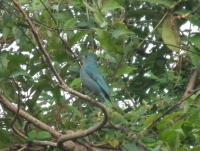
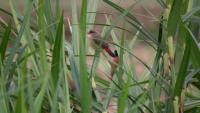
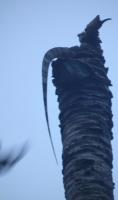

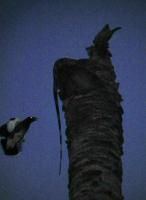

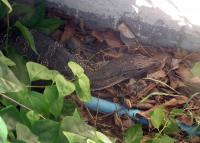
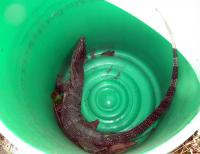
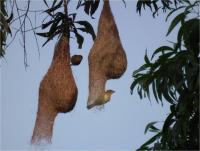
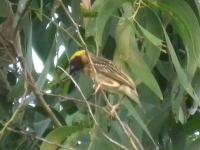
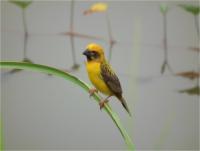
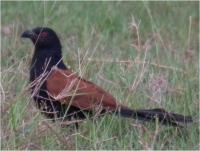
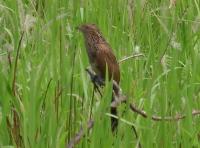
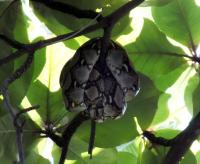

Birdwatching In Isan
in Isaan
Posted
I think I would have that down as a Large Hawk Cuuckoo, but I would wait and see what others say as I have no field experience with that species at all.